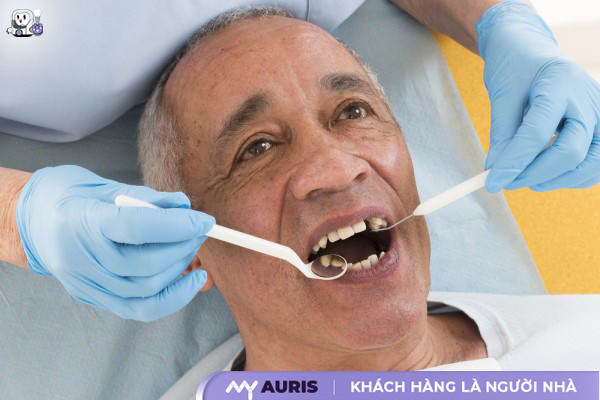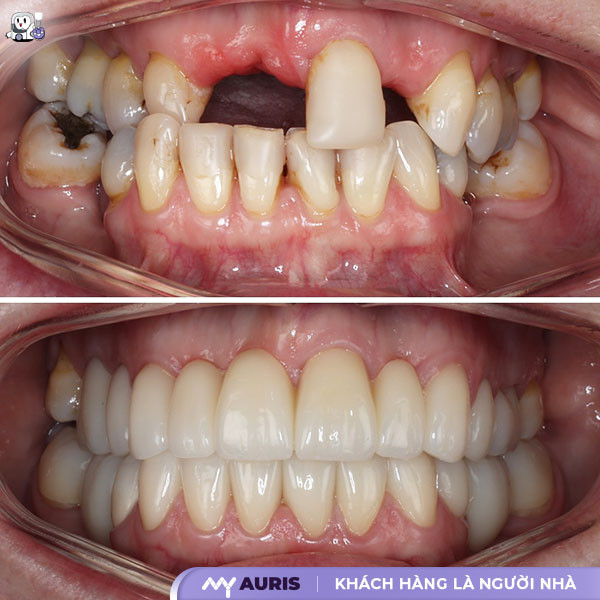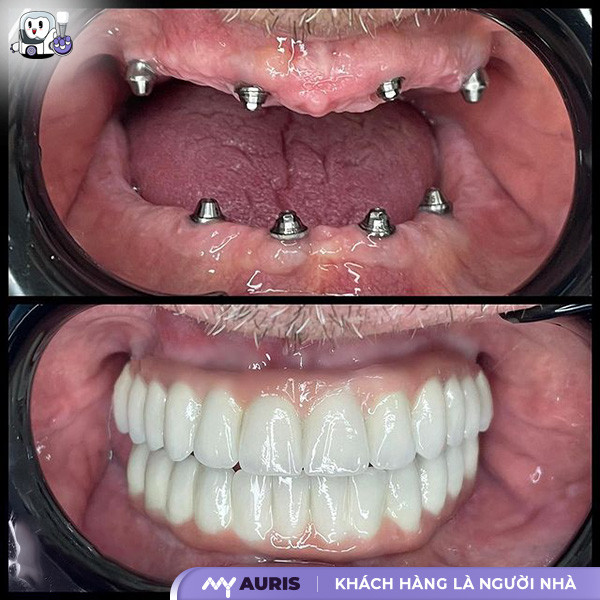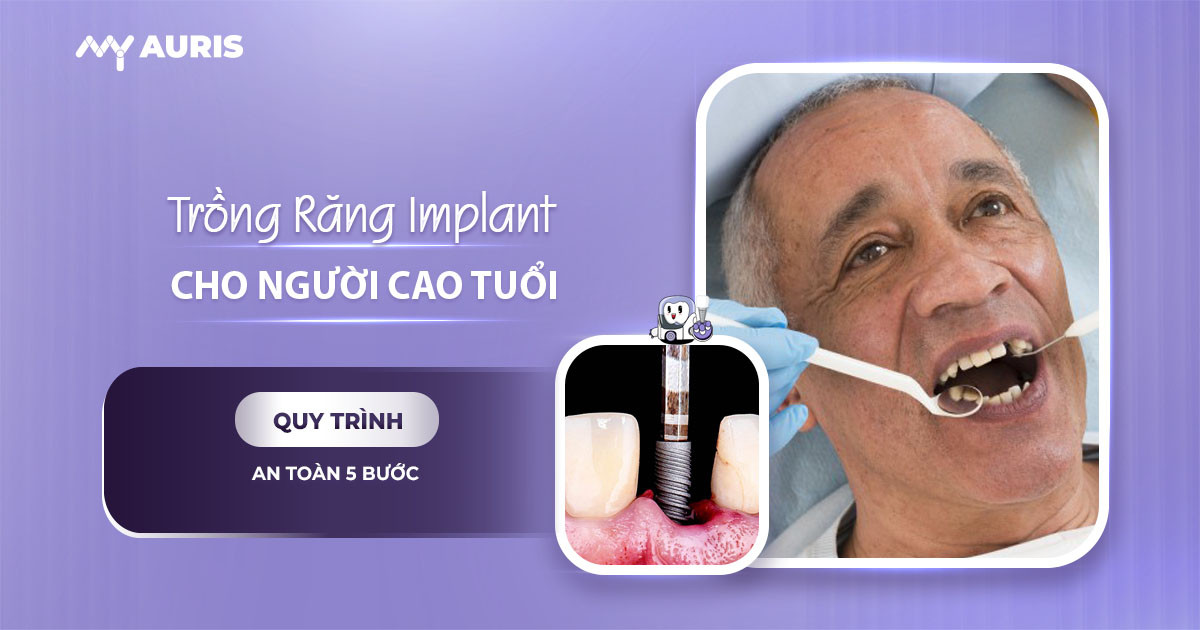Currently, among various prosthetic dental restoration methods, dental implant placement is considered the optimal solution, helping to restore chewing function almost like natural teeth. This technique involves placing a titanium post into the jawbone at the site of a missing tooth, providing long-term stability and durability. However, many still wonder: Can the elderly get dental implants? The answer will be addressed in the article below, based on professional assessments and practical treatment experiences at reputable dental clinics.
How much does denture work for the elderly cost?
The cost of dentures for the elderly depends on the method used, the type of teeth, and the specific tooth loss situation of each patient. Below is a reference price list for common methods:

Dental Implant Placement for Seniors
The cost of dental implants for seniors ranges from 13,000,000 – 35,000,000 VND/tooth, including the abutment and porcelain crown restoration. The price varies depending on the number of teeth to be implanted, oral health condition, as well as the quality, brand, origin of the implant post, and the dental clinic performing the procedure.
Although it has a higher cost compared to dental bridges and removable dentures, dental implant placement is currently the most advanced restoration method, capable of restoring over 95% of chewing function, natural aesthetics, and effectively preventing jawbone loss.
Example: A patient missing 3 teeth chooses the Mis C1 (Germany) implant post type at 26,000,000 VND/tooth, total cost: 26,000,000 x 3 = 78,000,000 VND. With a 15% discount applied, the cost is only 66,300,000 VND.
Total Implant Cost = Implant Post Price + Abutment + Porcelain Crown + Related Costs
| Implant Post Type | Unit | Price Range
(VNĐ) |
Healing Time | Warranty |
| Biotech Korea | 1 set | 12,250,000 | 6 months | 10 years |
| Premium Biotech Korea | 1 set | 15,500,000 | 3 – 6 months | 15 years |
| Dentium Korea | 1 set | 19,600,000 | 3 -6 months | 20 years |
| Dentium USA | 1 Set | 35,000,000 | 2 – 4 months | 30 years |
| HIOSSEN USA | 1 set | 28,500,000 | 2 months | 50 years |
| Zimmer Biomet USA | 1 set | 70,000,000 | 3 weeks | Lifetime |
| SIC Switzerland | 1 set | 40,000,000 | 2 months | Lifetime |
| Straumann Switzerland | 1 set | 45,000,000 | 2 months | Lifetime |
Additional costs (if needed):
- Minor bone graft (1-2 teeth): 8,000,000 VND/unit
- Major bone graft (>2 teeth): 15,000,000 VND/unit

Cost of porcelain dental bridges for seniors
The cost of a porcelain dental bridge ranges from 1,000,000 – 14,000,000 VND/tooth, depending on the type of tooth used:
- Metal-ceramic crowns: Lower price, shorter lifespan, moderate aesthetics.
- All-ceramic crowns: Higher price, greater durability and aesthetics, long-lasting.
Porcelain crown price list at My Auris Dental Clinic:
| Tooth Type | Cost |
| Zirconia Metal-Free Ceramic Crown (Germany) | ~ 1,500,000 – 3,000,000 VND/tooth
(Combo Price – 5-year warranty) |
| Vita USA Ceramic Crown | ~ 2,500,000 – 4,500,000 VND/tooth
(Combo Price – 8-year warranty) |
| Cercon HT/Nacera Ceramic Crown | ~ 3,500,000 – 6,000,000 VND/tooth
(Combo Price – 10 to 15-year warranty) |
| Lava Ceramic Crown | ~ 5,500,000 – 9,000,000 VND/tooth
(Combo Price – 20-year warranty) |
| Emax Press Ceramic Crown | ~ 6,000,000 – 12,000,000 VND/tooth
(Combo Price – 25-year warranty) |
| Amira (Lisi) Crystal Ceramic Crown | ~ 8,000,000 – 14,000,000 VND/tooth
(Combo Price – 30-year warranty) |
| Lucy Crystal Ceramic Crown | ~ 10,000,000 – 16,000,000 VND/tooth
(Combo Price – Lifetime warranty) |
| Irisa Orodent High Translucent Crystal Ceramic Crown | ~ 12,000,000 – 20,000,000 VND/tooth
(Combo Price – Lifetime warranty) |
| Endora Diamond Crystal Ceramic Crown | ~ 15,000,000 – 30,000,000 VND/tooth
(Combo Price – Lifetime warranty) |
Cost of removable dentures for seniors
The cost of removable dentures ranges from 300,000 – 1,000,000 VND/tooth or 1,500,000 – 10,000,000 VND/arch, depending on:
- Type of teeth: plastic teeth are cheaper than porcelain teeth
- Denture framework: plastic is cheaper than metal framework
- Number of missing teeth and the dental clinic performing the procedure
This method is low-cost, easy to remove and insert, and suitable for elderly individuals with limited financial resources.

Suitable solutions for dental implant placement in the elderly
In older adults, long-term or multiple tooth loss often occurs due to periodontitis or the aging process leading to jawbone resorption, where there isn’t enough bone height and thickness for implant placement. Unlike younger individuals who can easily undergo procedures like sinus lifts or bone grafting to increase bone volume and height, the elderly have poorer bone regeneration and lower tolerance, requiring a limitation on invasive procedures.
Due to poor jawbone structure and reduced blood flow, older adults are prone to bone loss and gum recession after implant placement. Therefore, doctors often recommend fewer implants instead of many posts as in younger individuals. Instead, a dental bridge will be restored on the implant posts to ensure chewing efficiency while being suitable for their health condition.
A gently invasive and highly effective solution currently recommended is the All-on-4 implant technique. This method uses 4 implant posts, consisting of 2 straight implants in the front and 2 angled implants in the back to support a full arch denture. The angled design in the posterior helps avoid important anatomical structures such as the maxillary sinus or the inferior alveolar nerve canal, thereby minimizing the need for sinus lifts or bone grafting.
Furthermore, after implant placement, patients can receive immediate temporary restorations, which helps maintain aesthetics and temporary chewing function while awaiting definitive restoration, significantly improving the quality of life for the elderly.
Should the elderly get dental implants?
Many seniors believe that dental implant restoration is only suitable for younger individuals. However, this is a misconception. In reality, dental implants offer numerous practical benefits for the elderly, helping to improve chewing function, facial aesthetics, and daily quality of life.
Elderly individuals with underlying medical conditions such as diabetes, high blood pressure, or heart disease can still undergo implant placement if their conditions are well-controlled. The dentist will conduct a comprehensive evaluation: jawbone density, gum tissue, blood indices, biocompatibility with the titanium implant post, and reaction to anesthetics.
In many cases, the elderly may not require bone grafting if their jawbone density is sufficient, or they can opt for the All-on-4 technique – a solution that doesn’t require many implant posts but still restores all missing teeth.
Thorough screening before treatment is a mandatory step to ensure maximum safety. The restorative dentist will provide appropriate indications for each individual based on the extent of jawbone loss, the number of missing teeth, and overall health status.

Necessary health conditions for implant placement in older adults
Not everyone can get dental implants immediately. Certain health conditions must be ensured before proceeding with implant placement to avoid complications and achieve long-term effectiveness:
Sufficient jawbone thickness with no severe atrophy
The first factor to assess is the condition of the jawbone. The bone needs to have sufficient density and volume to securely hold the implant post. Individuals with long-term tooth loss often experience bone resorption, which weakens the supporting foundation. In such cases, the restorative dentist may suggest bone grafting before implant placement to rebuild the bone foundation.
Furthermore, older adults with osteoporosis need to undergo testing and achieve stable treatment before getting dental implants. Precisely determining the extent of bone loss helps the doctor choose the appropriate technique, such as All-on-4 or short implant posts.
Well-controlled underlying medical conditions such as diabetes, cardiovascular disease, and high blood pressure
Older adults often suffer from chronic conditions such as diabetes, cardiovascular disease, and high blood pressure. These conditions directly affect the healing ability after implant placement. If blood sugar and blood pressure levels are well-controlled, patients can still safely undergo dental implant surgery.
The dentist needs to thoroughly evaluate the patient’s medical history, collaborating with an internist if necessary, to ensure there is no risk of infection or postoperative complications. Cases of temporary contraindications will have a treatment plan developed before implantation.
No allergies to anesthetics and good soft tissue regeneration capability
Allergies to anesthetics or implant materials are factors that need to be checked beforehand. Patients must inform the dentist of all their allergy history. Additionally, the ability of soft tissue to regenerate around the implant post plays a crucial role in maintaining stability and preventing gum infection.
Some older adults have aging gum tissue and less elastic soft tissue, requiring a personalized treatment plan to prevent peri-implantitis. This helps dental implants last longer and reduces the risk of failure.
Good oral hygiene and ability to cooperate with post-implant care
Implant placement is not just a single procedure but a continuous chain of care. Older adults need sufficient awareness and ability to maintain proper oral hygiene. Using a soft toothbrush, dental floss, and regular follow-up appointments will directly affect the durability of the implant.
If older adults cannot care for themselves, family members need to assist or find a dental clinic with suitable post-treatment care services. This is how to maintain the oral health of the elderly sustainably.
Financial situation and access to services
The cost of implant placement is not low. Older adults need to prepare financially beforehand or choose a clinic that offers installment plans and long-term warranties. Additionally, geographical distance and mobility can affect the schedule of regular follow-up appointments after implant placement.
A reputable restorative dental clinic should have an experienced team of doctors, advanced techniques, and support services for older adults, such as safe dental chairs and mobility assistance. This helps increase the success rate of dental restorations.

What is the dental implant placement procedure for seniors like?
Dental implant placement is a common solution for restoring missing teeth in older adults. Below are the specific steps to help you understand this process.
Step 1 – General examination and systemic health assessment
The dentist examines the patient’s oral cavity, jawbone, gums, and overall health. A 3D Cone Beam CT scan helps assess bone density and the risk of bone loss. Individuals with underlying medical conditions (diabetes, high blood pressure) need to have their conditions well-controlled before implant placement. This step determines whether the older adult is eligible for implant surgery.
Step 2 – Treatment planning and selecting the appropriate implant post type
Based on the examination results, the dentist will create a personalized treatment plan, including the placement site, type of implant post, and estimated timeframe. Highly biocompatible titanium implant posts are often preferred. For patients with full arch tooth loss, the All-on-4 or All-on-6 technique can shorten treatment time.
Step 3 – Implant post placement into the jawbone
The patient receives local anesthesia. The dentist creates a small opening in the jawbone and places the implant post in the predetermined position (approximately 20-30 minutes per post). Afterward, the soft tissue is sutured. The patient will be given instructions for care and medication. For older adults, the healing process is slower, so strict adherence is necessary to prevent infection and ensure good integration of the implant post.
Step 4 – Attaching the prosthetic porcelain crown and restoring chewing function
After 3-6 months, once the implant post has firmly integrated with the bone, the dentist will attach the abutment and the porcelain crown. The porcelain crown is custom-made to match the older adult’s face and bite. This restoration helps restore chewing and speaking functions like natural teeth, eliminating the inconvenience of removable dentures.
Step 5 – Follow-up examinations and maintaining regular implant care
After dental implant placement, older adults need to have regular follow-up examinations every 3-6 months to check the implant and gum tissue. Proper oral hygiene and a healthy diet will help the implant last longer. If well-cared for, implants can last 15-20 years, or even a lifetime, helping older adults chew healthily and confidently.
Common risks when placing implants in older adults
Older adults often have less stable overall health. This is one of the factors that makes the implant placement process more prone to complications compared to younger individuals. Some common risks include:
Post-surgical complications: Older adults may face prolonged bleeding, soft tissue swelling, fluid accumulation, or infection at the implant site. This is due to weakened immune systems, poor blood circulation, or the use of anticoagulants.
Prolonged jawbone resorption making implant post placement difficult: After many years of missing teeth without restoration, the jawbone tends to resorb severely. When bone density is no longer sufficient, the dentist may need to recommend bone grafting before proceeding with implant post placement.
Risk of implant rejection: Some cases involve biological incompatibility with the titanium post or underlying conditions like uncontrolled diabetes, leading to peri-implantitis at the implant site and failure to integrate with the jawbone.
Increased risk of recurrent periodontitis: If older adults have a history of periodontitis or poor oral hygiene, implants are susceptible to peri-implant tissue inflammation, leading to instability, loosening, or implant failure.
Impact from medications for underlying conditions: Some cardiovascular drugs, osteoporosis medications, or anticoagulants can directly affect the healing process or the ability of the implant post to integrate with the jawbone.
Notes to increase the success rate of implant placement in older adults
Pre-treatment evaluation plays a decisive role. Before dental implant surgery, older adults need to undergo a general health check, jawbone X-rays, and tests for important indices. Below are the steps to note:
Check for bone loss and gum tissue condition: If teeth have been missing for a long time and bone loss has occurred, it is necessary to assess whether bone grafting is needed. Techniques like All-on-4 allow implant placement without bone grafting, reducing treatment time.
Choose appropriate implant posts: The dentist should select highly biocompatible titanium implant posts. For older adults, short implant posts may be preferred if jawbone density is low.
Post-implant care regimen: After implant placement, older adults need to maintain oral hygiene using a soft toothbrush, saline solution, and avoid hard foods for the first 1-2 weeks. Regular follow-up appointments are mandatory.
Coordination between dentist and specialist: For individuals with underlying medical conditions such as diabetes, cardiovascular disease, or high blood pressure, there should be coordination between an internist and a restorative dentist to ensure treatment safety.
Carefully weigh benefits and costs: Dental implant placement for the elderly offers significant benefits in terms of chewing ability and quality of life. However, the treatment cost is quite high. Therefore, clear consultation is needed for clients to understand and make appropriate decisions.
Thus, it can be affirmed that older adults can absolutely get dental implants, provided they meet sufficient general health conditions and have their systemic diseases well-controlled. Through this article, we have also gained a better understanding of tooth loss in the elderly and the differences in implant placement techniques between older and younger individuals – thereby helping to choose the most suitable, effective, and safest dental restoration method.





